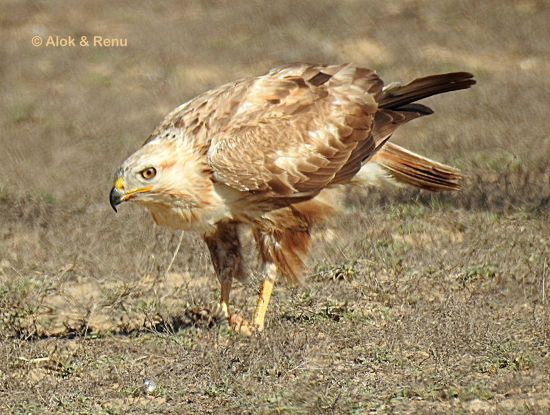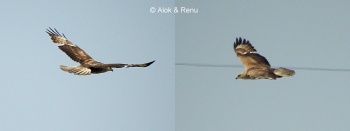(Minor tidy-up. Video link. References updated) |
m (→External Links: updated VSearch) |
||
| (17 intermediate revisions by 5 users not shown) | |||
| Line 1: | Line 1: | ||
| − | [[Image: | + | [[Image:long-legged_buzzard_3_alok.JPG|thumb|550px|right|Nominate subspecies<br />Photo © by {{user|aloktewari|Alok Tewari}}<br />Jorbeer Conservation Reserve, Bikaner, Rajasthan, [[India]], 22 February 2022]] |
;[[:Category:Buteo|Buteo]] rufinus | ;[[:Category:Buteo|Buteo]] rufinus | ||
==Identification== | ==Identification== | ||
43–62 cm (17-24½ in)<br /> | 43–62 cm (17-24½ in)<br /> | ||
| − | Plumage pattern very variable. | + | Plumage pattern very variable. Pale morph with an orangey hue to plumage. Red or orange tail, creamy-buff head and underparts, often with a rufous belly patch, and largely white underwings except for the dark carpal patch and narrow dark trailing edge. Dark morph birds are dark brown, less rufous, and also have dark underparts and underwing coverts, but still pale-based primaries and secondaries. |
| + | [[Image:long-legged_buzzard_2_alok.JPG|thumb|350px|right|Immature : nominate subspecies<br />Photo © by {{user|aloktewari|Alok Tewari}}<br />Nazafgarh Wetlands, Gurgaon-Delhi Border, Haryana, [[India]], 25 July 2016]] | ||
====Similar Species==== | ====Similar Species==== | ||
| − | + | Some birds, particularly immatures, are virtually indistinguishable from [[Common Buzzard]]s of the eastern subspecies ''B. b. vulpinus'' ("Steppe Buzzard"); Long-legged is best distinguished by structure, being larger (nominate subspecies only) and longer-winged, with a more [[:Category:Aquila|eagle]]-like profile in flight. Long-winged structure also reminiscent of [[Rough-legged Buzzard]]. In the Central Asian part of its range, [[Upland Buzzard]] also needs to be considered. | |
| + | |||
==Distribution== | ==Distribution== | ||
| − | + | Breeds in [[Europe]], [[Middle East]], northern [[Africa]], and [[Asia]] to [[India]] and [[Mongolia]]; winters to Africa south of Sahara. In Europe found in [[Turkey]], [[Greece]], [[Romania]], [[Bulgaria]], [[Hungary]] and increasingly in the south of [[Spain]], where it is now breeding in small numbers. | |
| − | Breeds in [[Europe]], [[Middle East]], northern [[Africa]], and [[Asia]] to [[India]] and [[Mongolia]]; winters to Africa south of Sahara. In Europe found in [[Turkey]], [[Greece]], [[Romania]], [[Bulgaria]], [[Hungary]] and increasingly | ||
==Taxonomy== | ==Taxonomy== | ||
| + | [[Image:LLB B078086 copy.jpg|thumb|350px|right|Nominate subspecies : under-wing in flight<br />Photo © by {{user|A.+Meir|A. Meir}}<br />Eilat, [[Israel]], 2007]] | ||
====Subspecies==== | ====Subspecies==== | ||
| − | Two subspecies are | + | Two subspecies are accepted<sup>[[#References|[1]]]</sup>: |
| − | *''B.r. | + | *''B. r. rufinus'' — southeastern Europe east to central Asia; also wintering south to Pakistan and northwestern India. Larger; 50-62 cm, wingspan 130-155 cm. |
| − | *''B.r. cirtensis'' | + | *''B. r. cirtensis'' — northern Africa to the [[Arabian Peninsula]]; a recent colonist in southern Spain. Smaller; 43-50 cm, wingspan 105-125 cm. |
==Habitat== | ==Habitat== | ||
| Line 21: | Line 23: | ||
==Behaviour== | ==Behaviour== | ||
====Diet==== | ====Diet==== | ||
| − | Diet | + | Diet mainly small rodents, although it will also take lizards, snakes, small birds and large insects. |
| + | [[Image:long-legged_buzzard_alok.jpg|thumb|350px|right|Nominate subspecies : upper-wing in flight<br />Photo © by {{user|aloktewari|Alok Tewari}}<br />Nazafgarh Wetlands, Gurgaon-Delhi Border, Haryana, [[India]], March-2018]] | ||
====Vocalisation==== | ====Vocalisation==== | ||
| − | + | ||
| − | + | {{ Audio|Buteo rufinus (song).mp3 }} | |
| + | |||
| + | [[Image:IMG 9112L.jpg|thumb|350px|right|Nominate subspecies juvenile<br />Photo © by {{user|Scridifer|Scridifer}}<br />Povelianovo, [[Bulgaria]], February 2017]] | ||
==References== | ==References== | ||
| − | #{{Ref- | + | #{{Ref-Clements6thAug18}}#Handbook of the Birds of the World Alive (retrieved March 2016) |
#Wikipedia | #Wikipedia | ||
#Collins Bird Guide 5th Edition | #Collins Bird Guide 5th Edition | ||
| Line 32: | Line 37: | ||
{{ref}} | {{ref}} | ||
==External Links== | ==External Links== | ||
| − | {{GSearch|Buteo | + | {{GSearch|"Buteo rufinus" {{!}} "Long-legged Buzzard"}} |
| + | <br /> | ||
| + | {{VSearch|"Buteo rufinus" {{!}} "Long-legged Buzzard"}} | ||
| + | {{GS-checked}}! | ||
| + | <br /> | ||
<br /> | <br /> | ||
| − | |||
| − | + | [[Category:Birds]][[Category:Buteo]][[Category:Bird Songs]][[Category:Videos]] | |
| − | [[Category:Birds]][[Category:Buteo]][[Category:Bird Songs]] [[Category:Videos]] | ||
Revision as of 13:55, 1 June 2023

Photo © by Alok Tewari
Jorbeer Conservation Reserve, Bikaner, Rajasthan, India, 22 February 2022
- Buteo rufinus
Identification
43–62 cm (17-24½ in)
Plumage pattern very variable. Pale morph with an orangey hue to plumage. Red or orange tail, creamy-buff head and underparts, often with a rufous belly patch, and largely white underwings except for the dark carpal patch and narrow dark trailing edge. Dark morph birds are dark brown, less rufous, and also have dark underparts and underwing coverts, but still pale-based primaries and secondaries.

Photo © by Alok Tewari
Nazafgarh Wetlands, Gurgaon-Delhi Border, Haryana, India, 25 July 2016
Similar Species
Some birds, particularly immatures, are virtually indistinguishable from Common Buzzards of the eastern subspecies B. b. vulpinus ("Steppe Buzzard"); Long-legged is best distinguished by structure, being larger (nominate subspecies only) and longer-winged, with a more eagle-like profile in flight. Long-winged structure also reminiscent of Rough-legged Buzzard. In the Central Asian part of its range, Upland Buzzard also needs to be considered.
Distribution
Breeds in Europe, Middle East, northern Africa, and Asia to India and Mongolia; winters to Africa south of Sahara. In Europe found in Turkey, Greece, Romania, Bulgaria, Hungary and increasingly in the south of Spain, where it is now breeding in small numbers.
Taxonomy
Subspecies
Two subspecies are accepted[1]:
- B. r. rufinus — southeastern Europe east to central Asia; also wintering south to Pakistan and northwestern India. Larger; 50-62 cm, wingspan 130-155 cm.
- B. r. cirtensis — northern Africa to the Arabian Peninsula; a recent colonist in southern Spain. Smaller; 43-50 cm, wingspan 105-125 cm.
Habitat
Open, uncultivated areas, with high bushes, trees, cliffs or hillocks. Steppe, semi-desert.
Behaviour
Diet
Diet mainly small rodents, although it will also take lizards, snakes, small birds and large insects.

Photo © by Alok Tewari
Nazafgarh Wetlands, Gurgaon-Delhi Border, Haryana, India, March-2018
Vocalisation
References
- Clements, J. F., T. S. Schulenberg, M. J. Iliff, D. Roberson, T. A. Fredericks, B. L. Sullivan, and C. L. Wood. 2018. The eBird/Clements checklist of birds of the world: v2018. Downloaded from http://www.birds.cornell.edu/clementschecklist/download/
- Handbook of the Birds of the World Alive (retrieved March 2016)
- Wikipedia
- Collins Bird Guide 5th Edition
- Paper describing identification features of Long-legged vs Upland Buzzards
Recommended Citation
- BirdForum Opus contributors. (2025) Long-legged Buzzard. In: BirdForum, the forum for wild birds and birding. Retrieved 11 May 2025 from https://www.birdforum.net/opus/Long-legged_Buzzard
External Links
GSearch checked for 2020 platform.!





